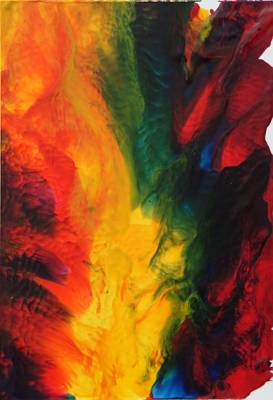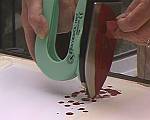 |
Use the iron in a vertical position then dribble off the initial colour
that is to be worked. Remember, in this approach no clear wax is applied
before-hand.
Note: Some colours are more viscous than
others.This difference affects the liquidity & flow of the various
colours when molten. |
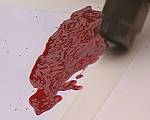 |
The hot air gun has been used to melt the initial splattering
of red drops. Adjust the temperature so that it is not too fierce. Prolonged
blowing in any particular area builds up the heat concentration. If it
gets too hot then you may find holes forming in the wax coating. Worse
still is that the card "pops" separating its two surfaces at the core,
creating an unresolvable issue. |
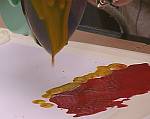 |
Once the initial area has been blown out into a coating
then further colour is added in the same manner as before.
Here the yellow
is dribbled off the iron face. It is positioned fairly carefully along
the border of the existing wax colour. |
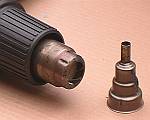 |
Time to fit a reduction nozzle.
This one steps the expelling
orifice down to a very small diameter, enabling fine control of the hot
air blast. These are specialised so check what nozzle attachments you can
get for your own hot air gun. They often use the same diameter as other
brands, so can sometimes be usefully adapted. |
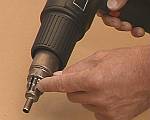 |
Small orifice nozzles like this one usually have a vent
hole or holes to enable the excess heated air to escape without having
to travel through the reduction nozzle itself. It is important for maximum
control that the nozzle is attached with these vent holes facing away from
the work surface, otherwise they can affect the wax where they blow out
onto the work in progress.
* This practise demonstration
was created with the vent holes actually facing the work. Look
carefully during the blowing action on the DVD & notice how the vented
air disturbs the wax colours way behind the intended work area. |
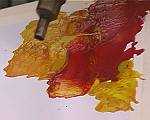 |
Once fitted you have far more accurate control of the heated
air jet as it blasts out from the gun. If you have an airflow control facility
on the tool then this is a good time to explore its value. With the air
flow turned down low the wax moves slowly, creating more time to choose
and control. With the air flow at maximum you have the strongest blowing
jet possible. This can force the wax to spread.. |
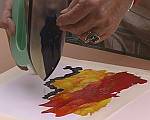 |
Moving on to blue, the third primary colour (red, yellow
& blue), more wax is added along the working edge of this piece. Choosing
appropriate colours will pay off. Where colours meet, if they are harmonic
then the resulting blend will be a transition. If the bordering colours
are opposite then darkness forms where they meet & blend. |
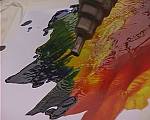 |
The affects of blowing the yellow and blue together during
the work process show up in the green as some of the yellow invades the
places where blue exists or has already been.
* Blown encaustic art work is one of the most magical
techniques for superb colour blending and fluidity of hue within
the wax paint medium. |
 |
Back to adding some more red on the outer boundary, still
letting the colour dribble off the vertical iron's face.
Notice how far the wax has been spread out by the blowing so far. The
colour blend of the yellow and blue has created quite a large green area
now. |
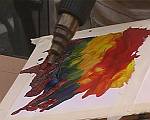 |
Lifting the rigid underboard means that the directional
flow of the air blast can be further amplified by use of gravity. The wax
is encouraged to blow right off, over the work area edge, so that when
the piece is finished the whole surface is covered.
*
The leading edge of
blown wax is often thicker, so once cool it can lead to potential for cracking
or flaking if flexed. Blowing it off the final area of the image means
that the wax coating is finer and the edges safer.
|
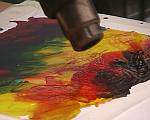 |
Almost there now. The main colours have been added to
the support, then blown, blended and moved, mostly with the restricting
nozzle attached. Here though, the main open tube of the hot air gun is
used to melt and fuse the colours in a more general and less forceful
manner. This relaxes the surface of the wax, evening out and lumps or
lines in a soft way.
|
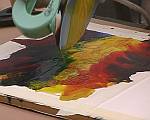 |
More yellow is added to boost the liquidity of the wax so
that the hot air can move it with less blowing force. Lots of wax makes
a more liquid piece than less wax. But each of the various colours and
wax types that you might use will have its own specific character, liquidity,
viscosity and flow qualities. To play with wax is a bit like learning the
unique qualities of an instrument. All are different. |
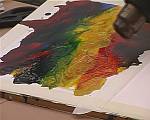 |
So now, with the wax spread out over the edges, enough has
been conveyed through this demonstration by Elisabeth Van Uden. A final
blow over to allow the whole thing to bond and cool as one image, then
let it get cold before removing the masking tape on each edge and liberating
another creation into the world. |
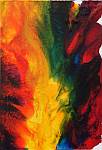 |
Once the piece is totally cool the colours can be lightly
polished with a tissue pad. Some use old soft tee-shirt material, others
use nylon stocking pads for that final silky sheen. Whatever you use, polish
until there are no signs of polishing lines in the wax.
*
Dental technicians
use water to help polish wax for perfect moulds. So dampening your final
soft fabric can just add that touch of excellence to radiate out the power
of colours and blends, indeed, all the work you have just done. |
|
|










